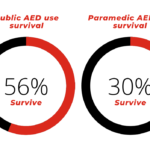Researchers have pinpointed Australian regions with high rates of cardiac arrest and low rates of CPR, highlighting the need for targeted education campaigns to raise awareness about preventing and treating heart issues.
A project led by Monash University, funded by the Heart Foundation and conducted by the Australian Resuscitation Outcomes Consortium (Aus-ROC), has identified areas with a high incidence of out-of-hospital cardiac arrest (OHCA) and low rates of bystander cardiopulmonary resuscitation (CPR).
Cardiac arrest, which occurs when the heart stops beating, is different from a heart attack, although heart attacks can lead to cardiac arrest. Not all cardiac arrests are caused by heart attacks.
Australia experiences approximately 26,000 out-of-hospital cardiac arrests annually. Of these cases, only 12% of patients treated by ambulance survive to hospital discharge or 30 days.
Professor Janet Bray, senior author from Monash University’s School of Public Health and Preventive Medicine and Curtin University’s Prehospital, Resuscitation and Emergency Care Research Unit, emphasized the importance of the Chain of Survival interventions for cardiac arrest.
“Early bystander CPR is one of the most crucial interventions,” Professor Bray stated. “Survival rates double when CPR is administered by bystanders.”
The study, published in PLOS ONE, is a retrospective, observational analysis that used data from the Aus-ROC Australian and New Zealand OHCA Registry to map OHCAs by local government area (LGA) from 2017 to 2019. The researchers used mathematical models and mapping techniques to estimate incidence and bystander CPR rates for witnessed events in each LGA.
High-risk LGAs were identified as those with an incidence rate above the 75th percentile and a bystander CPR rate below the 25th percentile for their state or territory. The study included 62,579 OHCA cases attended by ambulances across 543 LGAs nationwide.
Sixty high-risk LGAs, with a combined population of 1.17 million, were identified, predominantly in New South Wales. Most of these areas were regional and remote, with exceptions including two in Adelaide and two in Perth.
Nationally, OHCA incidence rates across LGAs varied from 58.5 to 198.3 per 100,000 people, while bystander CPR rates ranged from 45% to 75%.
Professor Bray highlighted the significant variation in OHCA incidence and bystander CPR rates across Australian LGAs, underscoring the need for targeted education campaigns in high-risk areas.
Previous Aus-ROC research with Ambulance Victoria found that Victorian regions with high OHCA rates often had populations with higher cardiovascular risk factors, such as older age, lower socioeconomic status and education levels, and higher smoking rates.
The incidence of OHCA decreased during the Heart Foundation’s Warning Signs campaign for heart attacks, suggesting that quick action when experiencing heart attack symptoms can prevent cardiac arrests.
“Regions with higher bystander CPR rates had higher levels of CPR training,” Professor Bray noted. “Ambulance Victoria and the Heart Foundation have since provided community education in these regions through their Heart Safe Community initiative.
“This body of work demonstrates that public education can improve OHCA outcomes and that we can now focus our efforts on areas with the greatest need across Australia.
“Many high-risk regions are in regional and remote areas. We are currently conducting research in NSW to explore community-based approaches to improve OHCA outcomes in these areas, and we are piloting a program in Victoria to teach high school students life-saving skills.”
While similar analyses have been conducted on regional OHCA variations in Queensland and Victoria, this study is the first to apply these methods across all Australian states and territories.
The organisations involved in this study include Monash University, Curtin University, Queensland University of Technology, Auckland University of Technology, Queensland Ambulance Service, St John Western Australia, NSW Ambulance, Ambulance Victoria, SA Ambulance Service, St John Ambulance NT, ACT Ambulance, and Ambulance Tasmania.
For a full list of LGAs and their risk status, click here.
Source: Monash University





